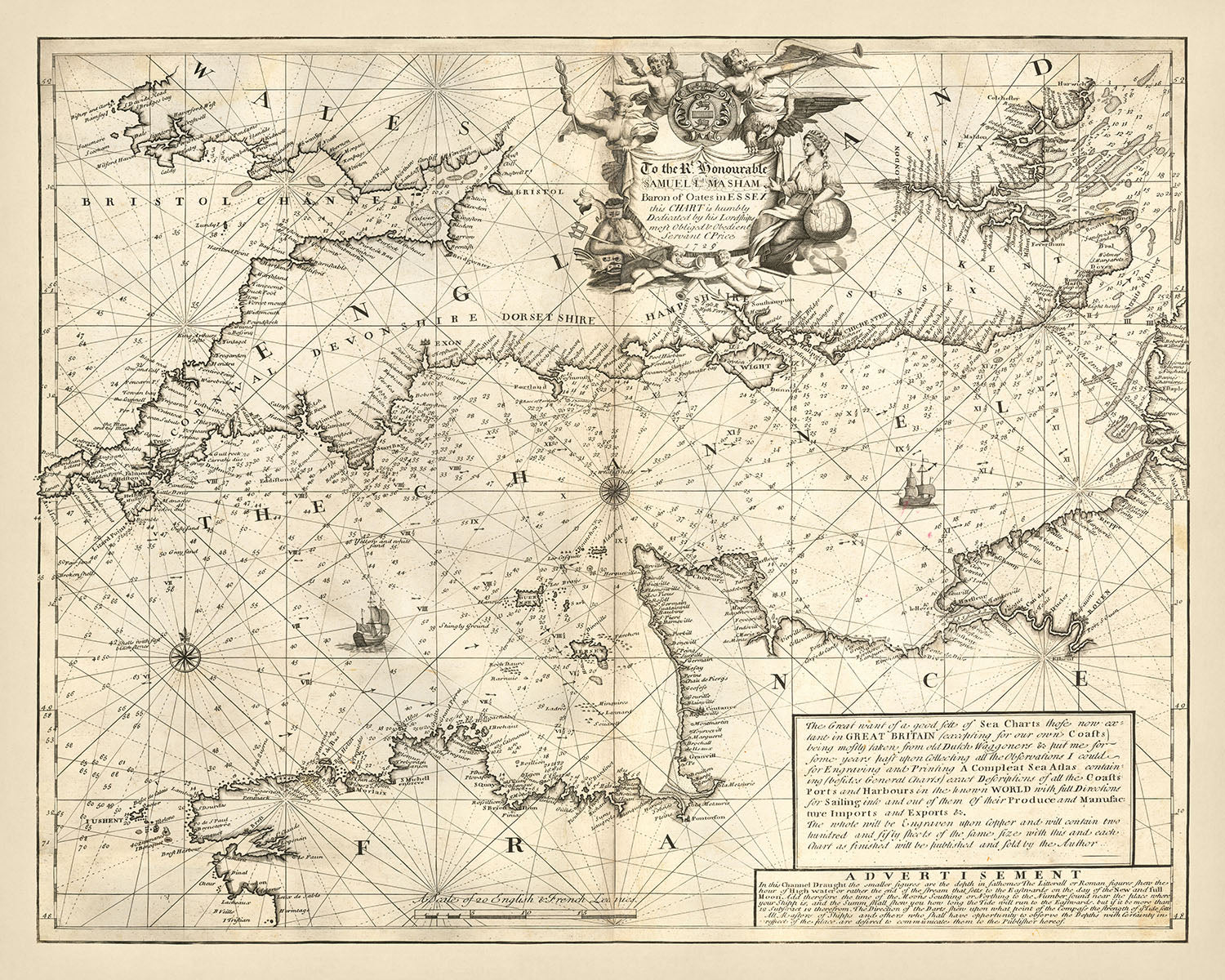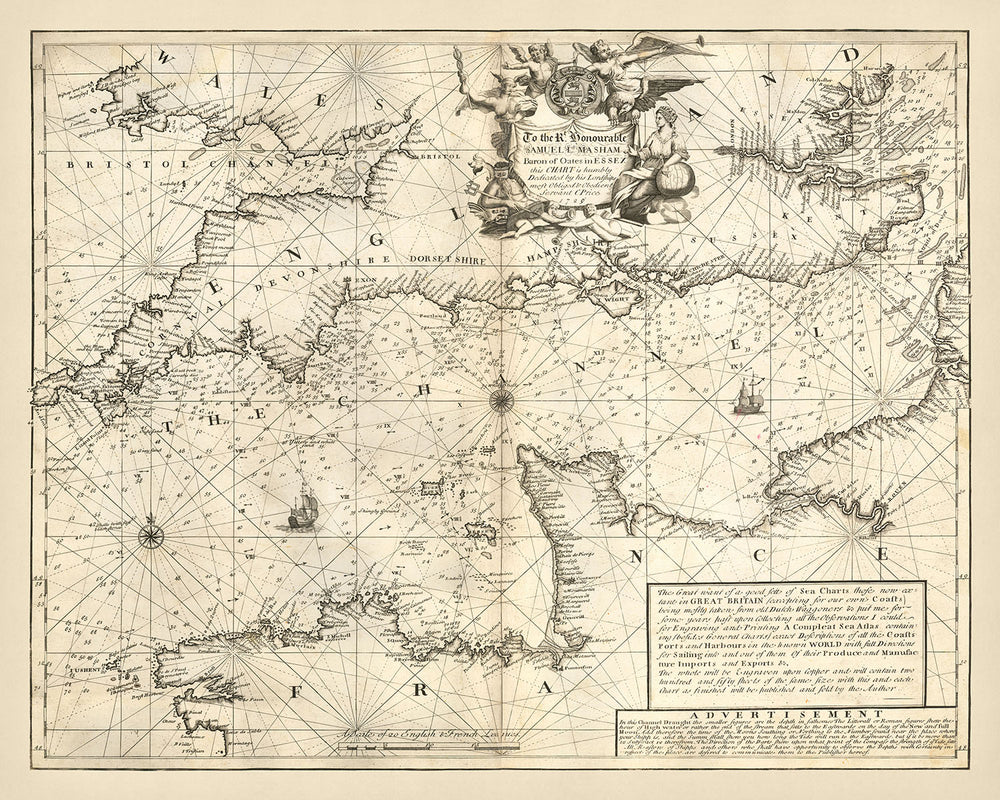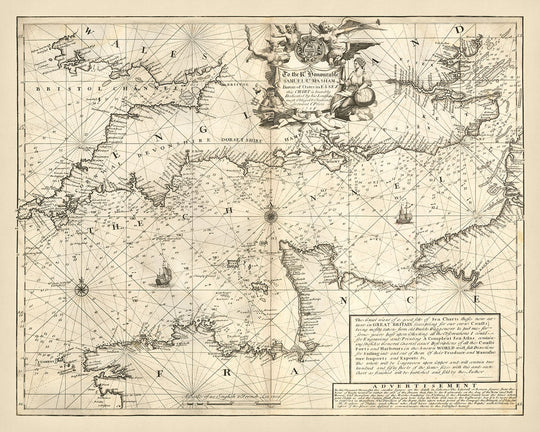- Handmade locally. No import duty or tax
- FREE worldwide delivery
- Love it or your money back (90 days)
- Questions? WhatsApp me any time
Own a piece of history
5,000+ 5 star reviews


Embark on a maritime journey through history with "Samuel Price's Chart of the British Channel," a masterpiece crafted by the esteemed Charles Price in 1729. This naval chart is not merely a navigational tool but a window into the 18th-century maritime landscape, meticulously documenting the intricate dance of the English Channel's waters. Charles Price, a distinguished bookseller, publisher, and esteemed member of both the Royal Society and the Royal Academy of Sciences in Berlin, poured his vast knowledge and passion for cartography into this creation. His dedication to precision and detail has immortalized the southern coast of England, parts of Wales, the northern coast of France, and the Channel Islands in a way that transcends time, offering us a glimpse into the maritime routes and challenges of yesteryears.
The chart's geographical scope is as breathtaking as its historical significance, covering the south coast of England up to Harwich in the northeast, and Pembrokeshire in the northwest. It beautifully captures the essence of the northern French coast, including Normandy, Brittany, and parts of Picardy, albeit leaving Calais just beyond its reach. This meticulous attention to detail extends to the labeling of only coastal towns and significant landmarks such as London, Southwark, and Woolwich along the Thames. Such precision not only served the navigational needs of the 18th-century seafarers but now provides us with a valuable historical document that showcases the geographical knowledge and maritime importance of these regions during the period.
Beyond its practical maritime utility, the chart is adorned with artistic elements that elevate it from a mere sea chart to a work of art. The dedication to Samuel Masham, 1st Baron Masham, is flanked by two cherubs, embodying the elegance and reverence of the era. A compass rose and rhumb lines guide the mariner's path, while decorative flourishes and illustrations of notable features like the Eddystone Lighthouse, the Goodwin Sands, and the Isle of Wight add a layer of aesthetic pleasure and historical context to the chart, making it a prized possession for collectors and enthusiasts alike.
The rarity of this chart adds to its allure. Originally intended for inclusion in Charles Price's ambitious "Atlas maritimus, or, A new sea atlas," the chart's journey is as tumultuous as the seas it depicts. Price's vision for a comprehensive sea atlas, addressing the "Great want of a good sett of Sea Charts" in Great Britain, was cut short as he found himself in debtor's prison in 1731. The atlas, a rarity with no known examples in British Institutions, survives in a few precious copies, making this chart a remarkable survivor of history, ambition, and the unforgiving nature of the sea.
In summary, "Samuel Price's Chart of the British Channel" is more than a map; it is a testament to the art of cartography, the ambition of its creator, and the rich maritime history of the 18th century. It captures the complexity of the English Channel's geography, the strategic importance of its coastal towns, and the beauty of its maritime landscape. For collectors, historians, and maritime enthusiasts, this chart is not just a purchase; it's an investment in a piece of history that continues to tell the story of an era where the sea was both a challenge and a pathway to new horizons.
Cities and towns on this map
- England:
- London (modern day population: 8,982,000)
- Bristol (463,400)
- Southampton (253,600)
- Portsmouth (205,400)
- Brighton (203,000)
- Plymouth (264,400)
- Exeter (129,800)
- Weymouth (71,700)
- Dorchester (19,000)
- Bridport (13,700)
-
Lyme Regis (4,000)
-
France:
- Cherbourg (82,500)
- Barfleur (620)
- Saint-Vaast-la-Hougue (2,100)
- La Hougue (1,800)
- Saint-Malo (46,000)
- Dinard (10,500)
- Saint-Brieuc (44,500)
- Paimpol (5,300)
- Tréguier (2,600)
- Lannion (20,200)
- Morlaix (15,000)
- Roscoff (3,500)
- Brest (140,000)
- Le Conquet (2,700)
- Camaret-sur-Mer (2,600)
- Crozon (7,300)
- Douarnenez (14,200)
- Audierne (3,700)
- Pont-l'Abbé (8,400)
- Quimper (63,000)
- Concarneau (20,200)
- Lorient (57,500)
- Port-Louis (2,700)
- Quiberon (5,000)
- Belle-Île-en-Mer (5,300)
- Houat (220)
-
Hoëdic (120)
-
Channel Islands:
- Saint Peter Port (18,200)
- Saint Helier (33,500)
Notable Features & Landmarks
- Bodies of water: The English Channel, The Atlantic Ocean, The Bristol Channel, The Celtic Sea, The Irish Sea, The North Sea
- Borders: The border between England and Wales
- Mountains: The Cheviot Hills
- Illustrations: A dedication to Samuel Masham, 1st Baron Masham, two cherubs, a compass rose, rhumb lines, decorative flourishes
- Other: The Goodwin Sands, The Isle of Wight, The Scilly Isles, Eddystone Lighthouse
Historical and design context
- The map is titled "Samuel Price's Chart of the British Channel, from the Land's End to the North Foreland: With the Soundings, Sands, Rocks, &c. Exactly laid down, and the Courses and Distances from Place to Place, According to the Observations of the Most Experienced Pilots".
- Created by Charles Price in 1729, a known bookseller and publisher who was a member of the Royal Society and the Royal Academy of Sciences in Berlin.
- The map is a Country Naval Chart, showcasing the south coast of England up to Harwich in the northeast, and Pembrokeshire in the northwest, along with most of the northern coast of France, including Normandy and Brittany.
- It is a valuable historical document providing a snapshot of the English Channel in the 18th century, and a beautiful example of cartography from the period.
- Part of Charles Price's ambitious project for "Atlas maritimus, or, A new sea atlas," intended to address the need for comprehensive sea charts in Great Britain.
Please double check the images to make sure that a specific town or place is shown on this map. You can also get in touch and ask us to check the map for you.
This map looks great at every size, but I always recommend going for a larger size if you have space. That way you can easily make out all of the details.
This map looks amazing at sizes all the way up to 100in (250cm). If you are looking for a larger map, please get in touch.
The model in the listing images is holding the 16x20in (40x50cm) version of this map.
The fifth listing image shows an example of my map personalisation service.
If you’re looking for something slightly different, check out my collection of the best old maps to see if something else catches your eye.
Please contact me to check if a certain location, landmark or feature is shown on this map.
This would make a wonderful birthday, Christmas, Father's Day, work leaving, anniversary or housewarming gift for someone from the areas covered by this map.
This map is available as a giclée print on acid free archival matte paper, or you can buy it framed. The frame is a nice, simple black frame that suits most aesthetics. Please get in touch if you'd like a different frame colour or material. My frames are glazed with super-clear museum-grade acrylic (perspex/acrylite), which is significantly less reflective than glass, safer, and will always arrive in perfect condition.
This map is also available as a float framed canvas, sometimes known as a shadow gap framed canvas or canvas floater. The map is printed on artist's cotton canvas and then stretched over a handmade box frame. We then "float" the canvas inside a wooden frame, which is available in a range of colours (black, dark brown, oak, antique gold and white). This is a wonderful way to present a map without glazing in front. See some examples of float framed canvas maps and explore the differences between my different finishes.
For something truly unique, this map is also available in "Unique 3D", our trademarked process that dramatically transforms the map so that it has a wonderful sense of depth. We combine the original map with detailed topography and elevation data, so that mountains and the terrain really "pop". For more info and examples of 3D maps, check my Unique 3D page.
For most orders, delivery time is about 3 working days. Personalised and customised products take longer, as I have to do the personalisation and send it to you for approval, which usually takes 1 or 2 days.
Please note that very large framed orders usually take longer to make and deliver.
If you need your order to arrive by a certain date, please contact me before you order so that we can find the best way of making sure you get your order in time.
I print and frame maps and artwork in 23 countries around the world. This means your order will be made locally, which cuts down on delivery time and ensures that it won't be damaged during delivery. You'll never pay customs or import duty, and we'll put less CO2 into the air.
All of my maps and art prints are well packaged and sent in a rugged tube if unframed, or surrounded by foam if framed.
I try to send out all orders within 1 or 2 days of receiving your order, though some products (like face masks, mugs and tote bags) can take longer to make.
If you select Express Delivery at checkout your order we will prioritise your order and send it out by 1-day courier (Fedex, DHL, UPS, Parcelforce).
Next Day delivery is also available in some countries (US, UK, Singapore, UAE) but please try to order early in the day so that we can get it sent out on time.
My standard frame is a gallery style black ash hardwood frame. It is simple and quite modern looking. My standard frame is around 20mm (0.8in) wide.
I use super-clear acrylic (perspex/acrylite) for the frame glass. It's lighter and safer than glass - and it looks better, as the reflectivity is lower.
Six standard frame colours are available for free (black, dark brown, dark grey, oak, white and antique gold). Custom framing and mounting/matting is available if you're looking for something else.
Most maps, art and illustrations are also available as a framed canvas. We use matte (not shiny) cotton canvas, stretch it over a sustainably sourced box wood frame, and then 'float' the piece within a wood frame. The end result is quite beautiful, and there's no glazing to get in the way.
All frames are provided "ready to hang", with either a string or brackets on the back. Very large frames will have heavy duty hanging plates and/or a mounting baton. If you have any questions, please get in touch.
See some examples of my framed maps and framed canvas maps.
Alternatively, I can also supply old maps and artwork on canvas, foam board, cotton rag and other materials.
If you want to frame your map or artwork yourself, please read my size guide first.
My maps are extremely high quality reproductions of original maps.
I source original, rare maps from libraries, auction houses and private collections around the world, restore them at my London workshop, and then use specialist giclée inks and printers to create beautiful maps that look even better than the original.
My maps are printed on acid-free archival matte (not glossy) paper that feels very high quality and almost like card. In technical terms the paper weight/thickness is 10mil/200gsm. It's perfect for framing.
I print with Epson ultrachrome giclée UV fade resistant pigment inks - some of the best inks you can find.
I can also make maps on canvas, cotton rag and other exotic materials.
Learn more about The Unique Maps Co.
Map personalisation
If you're looking for the perfect anniversary or housewarming gift, I can personalise your map to make it truly unique. For example, I can add a short message, or highlight an important location, or add your family's coat of arms.
The options are almost infinite. Please see my map personalisation page for some wonderful examples of what's possible.
To order a personalised map, select "personalise your map" before adding it to your basket.
Get in touch if you're looking for more complex customisations and personalisations.
Map ageing
I have been asked hundreds of times over the years by customers if they could buy a map that looks even older.
Well, now you can, by selecting Aged before you add a map to your basket.
All the product photos you see on this page show the map in its Original form. This is what the map looks like today.
If you select Aged, I will age your map by hand, using a special and unique process developed through years of studying old maps, talking to researchers to understand the chemistry of aging paper, and of course... lots of practice!
If you're unsure, stick to the Original colour of the map. If you want something a bit darker and older looking, go for Aged.
If you are not happy with your order for any reason, contact me and I'll get it fixed ASAP, free of charge. Please see my returns and refund policy for more information.
I am very confident you will like your restored map or art print. I have been doing this since 1984. I'm a 5-star Etsy seller. I have sold tens of thousands of maps and art prints and have over 5,000 real 5-star reviews. My work has been featured in interior design magazines, on the BBC, and on the walls of dozens of 5-star hotels.
I use a unique process to restore maps and artwork that is massively time consuming and labour intensive. Hunting down the original maps and illustrations can take months. I use state of the art and eye-wateringly expensive technology to scan and restore them. As a result, I guarantee my maps and art prints are a cut above the rest. I stand by my products and will always make sure you're 100% happy with what you receive.
Almost all of my maps and art prints look amazing at large sizes (200cm, 6.5ft+) and I can frame and deliver them to you as well, via special oversized courier. Contact me to discuss your specific needs.
Or try searching for something!















































